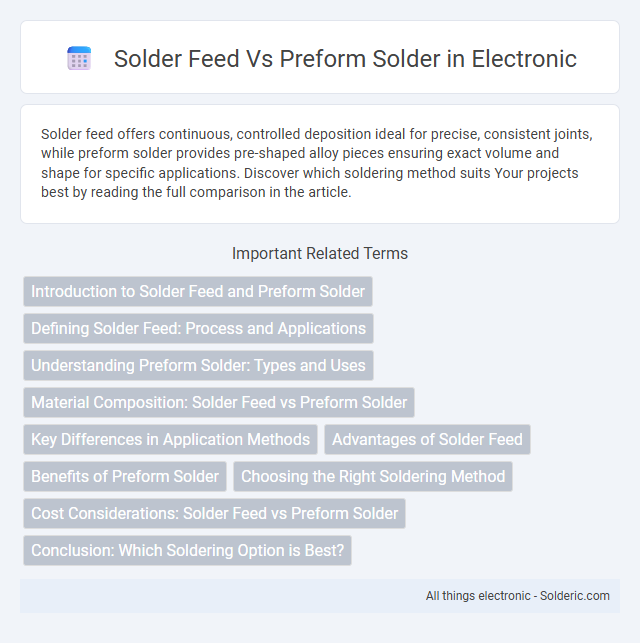Solder feed offers continuous, controlled deposition ideal for precise, consistent joints, while preform solder provides pre-shaped alloy pieces ensuring exact volume and shape for specific applications. Discover which soldering method suits Your projects best by reading the full comparison in the article.
Comparison Table
| Feature | Solder Feed | Preform Solder |
|---|---|---|
| Definition | Continuous wire or ribbon of solder used in automated or manual soldering | Precisely shaped, pre-measured solder shapes designed for specific joint sizes |
| Application | Ideal for wave soldering, hand soldering, and reflow processes | Best for high-precision, repeatable solder joints in SMT and BGA assembly |
| Material Control | Less precise; depends on operator skill or machine settings | Exact solder volume and composition guaranteed per joint |
| Consistency | Variable, affected by feed rate and operator technique | High consistency and uniformity in solder joints |
| Cost | Lower upfront cost, higher waste potential | Higher initial cost, reduced waste and rework |
| Waste & Efficiency | More solder waste, less efficient for mass production | Minimal waste, optimized for high-volume and reliable production |
| Typical Use Cases | Prototyping, repair, general electronics assembly | High-reliability electronics, aerospace, medical device manufacturing |
Introduction to Solder Feed and Preform Solder
Solder feed consists of continuous wire or ribbon used for manual or automated soldering, offering flexibility in length and application, while preform solder involves precisely shaped, pre-measured solder pieces tailored for specific joints to ensure consistent volume and placement. The choice between solder feed and preform solder impacts solder joint reliability, process efficiency, and material waste, with solder feed often favored for general use and preforms preferred in high-precision electronics or aerospace manufacturing. Key considerations include thermal profiles, joint geometry, and flux compatibility for optimal soldering outcomes.
Defining Solder Feed: Process and Applications
Solder feed refers to the continuous metal wire or ribbon used as a source of solder material in automated soldering processes, providing precise control over the amount of solder deposited. Commonly applied in wave soldering, selective soldering, and soldering robots, solder feed ensures consistent joint quality and efficient material usage. Its adaptability makes it essential for high-volume electronics assembly, where reliable and repeatable solder application is critical.
Understanding Preform Solder: Types and Uses
Preform solder offers precise metallurgical composition and shape, ensuring consistent solder joints in electronics and aerospace applications. Common types include bar, washer, ribbon, and customized geometries tailored for specific thermal profiles and mechanical stresses. Its controlled size and alloy distribution reduce waste and improve reliability compared to traditional solder feed methods.
Material Composition: Solder Feed vs Preform Solder
Solder feed typically consists of uniform wire or ribbon form made from alloys such as tin-lead, tin-silver-copper, or lead-free compositions tailored for consistent melting properties. Preform solder is manufactured into precise shapes and sizes using similar alloy compositions but offers controlled metal distribution for repetitive, exact solder joints. The material composition in both methods ensures reliability, though preforms enhance precision in applications requiring uniform thermal profiles and minimal material waste.
Key Differences in Application Methods
Solder feed involves continuously supplying solder wire to the joint during the soldering process, making it ideal for manual and automated tasks requiring flexibility and precision. Preform solder consists of pre-cut, shaped solder pieces placed directly onto the joint area, ensuring consistent solder volume and uniformity, which enhances reliability in repeatable assembly operations. Understanding these application method differences helps you choose the most efficient soldering approach based on your project's precision and production consistency needs.
Advantages of Solder Feed
Solder feed provides precise control over the amount of solder applied, reducing waste and improving joint consistency in electronic assemblies. Its continuous application simplifies automation, enhancing production speed and efficiency compared to preform solder. You can achieve greater flexibility in complex soldering tasks with solder feed, optimizing both cost and quality.
Benefits of Preform Solder
Preform solder offers precise alloy composition and exact shape control, ensuring consistent solder joints and reducing waste in manufacturing processes. Its consistent size and weight improve repeatability and reliability, especially in complex or miniaturized electronic assemblies. Preform solder also enhances efficiency by eliminating the need for manual solder wire feeding and minimizing rework due to poor solder volume control.
Choosing the Right Soldering Method
Choosing between solder feed and preform solder depends on application precision and production volume requirements. Solder feed offers flexibility for manual and automated processes, ideal for varied joint sizes, while preform solder provides consistent, reliable solder amounts for high-precision electronic assemblies. Factors such as thermal sensitivity, joint geometry, and manufacturing repeatability dictate the optimal soldering method selection.
Cost Considerations: Solder Feed vs Preform Solder
Solder feed offers lower initial costs due to its bulk packaging and widespread availability, making it a cost-effective choice for high-volume, automated soldering processes. Preform solder involves higher upfront expenses owing to precision manufacturing and custom shapes but reduces waste and improves joint consistency, potentially lowering overall production costs in complex or high-reliability applications. Evaluating total cost of ownership should consider material utilization rates, labor, and rework costs alongside raw solder prices for both options.
Conclusion: Which Soldering Option is Best?
Solder feed provides flexibility for custom joint sizes and continuous operation, ideal for manual and automated processes requiring varying solder amounts. Preform solder ensures precise, consistent solder volume and repeatable joint quality, making it suitable for high-volume production with tight tolerances. Choosing the best option depends on the specific application, production scale, and precision requirements, with preforms excelling in repeatability and solder feed in adaptability.
Solder feed vs preform solder Infographic

 solderic.com
solderic.com